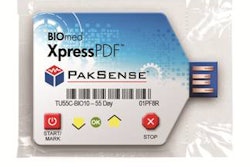The equipment is high-tech and high maintenance. It requires an extra dose of operator training, advanced cleaning techniques, and the willingness to periodically update capabilities and analyze their effectiveness. The following practices are recommended to those specifying new or upgraded coding and marking equipment for primary packaging:
1. Know your operation. Careful analysis can make the difference between a successful coding installation and one that experiences needless downtime, resulting in unhappy customers. Once you know these factors, it will be easier to choose which marking and coding technology is best for your application. Key factors to consider include:
• Types of materials or substrates you’ll be marking
• Desired speed of application or throughput
• Print quality: permanence and readability
• Up-front investment your company is willing to make
• Whether variable data, graphics, and bar codes are needed
• The distribution cycle characteristics for your packaging
2. Find room on the package, and room on the line. Make certain an area of “real estate” on the package is available and accessible to coding and marking equipment during the packaging process. To accomplish this, make sure your packaging line OEM works with your coding supplier early on to ensure all the necessary requirements for integrating the marking and coding equipment are considered. Too often, marking and coding is an afterthought in the line layout, and packagers find themselves scrambling to find an area on the package to mark the variable information, like date and lot number, and an accessible area of the packaging line to accept the marking and coding equipment.
3. Know your coding options. Ink-jet doesn’t work for logos on a primary package. Some types of ink-jet technologies don’t do bar codes well; use thermal transfer instead for bar-code applications. Specify to the vendor the grade, printing substrate, and printing application. Fully understanding the application will reduce costs and increase coding efficiency. On-demand or preprinted labels? Preprinted labels work for operations that have a volume of identical labels with many colors or complex graphics, because this option saves both time and money. However, to be flexible and responsive to operational changes, on-demand labels can provide a solution for those with variable data.
Ink-jet, laser, or thermal printing? Ink jet works well for printing cartons and product packaging, but is not necessarily ideal for all bar-coding applications. Laser printing works for some bar-code applications, but requires an area to be printed on the label (assuming a white label) that can be “burned” off to leave the variable information behind. Its higher up-front costs (compared to ink jet) are offset by the fact that laser printers run longer without issues, are cleaner, and have almost no moving parts. Direct thermal is a simple process that works well with printed labels that have a short shelf life and are not exposed to heat, sunlight, or rough handling. Thermal transfer can handle heat and moisture as well as the vagaries of shipping and the distribution environment. When looking at the options, don’t just consider cost of hardware—think about costs of supplies and consumables as well. If you are presenting a prospective supplier with a challenging application, an online demo of the equipment you are considering is always a wise choice and in most cases will make your decision much easier.
4. Value versatility. How versatile is the coding system? Are you choosing a flexible solution that enables quick response to new packaging substrates or configurations? Brand owners understand that new and “fresh” packaging has a direct and positive impact on sales. New packaging configurations are changing faster than ever. Can your coding system adapt?
5. Realize that no machine is an island. Can the coding system you’re considering be integrated for improved efficiency? Historically, coding and marking printers have been purchased and installed as stand-alone devices. Today, automation and integration is increasingly important for improving efficiencies and as a means of reducing errors. For example, packagers are networking coding equipment in their plants, both horizontally and vertically. In other words, they are creating a central command post that manages information not only among production lines, but also among primary, secondary, and tertiary coding systems. The ability to enter a product code one time and have it quickly download from product to pallet printing stations can save significant time and reduce message entry errors. There are solutions available today that offer a coding automation platform that provides a modular approach, allowing entry-level investment that can grow into fully automated integrated systems.
6. Find a coding partner. Consider investing some time up front to find a coding and marking partner and simplify your life. Most plants have multiple brands of printers. This makes managing your printer fleet and coding supplier relationships complex. Large suppliers that can install and service one brand of printers that serves all coding needs (up and down the production line) can make your life easier with coding user interfaces, technical training, and service programs—not to mention one phone number to call for your coding requirements. Obviously this increases sales for the big vendors, but it provides cost and time benefits for packagers as well.
7. Know the operating costs. While initial cost is a significant factor, the cost of ownership has the most impact on budgets over time, as well as effect on the supply chain relative to production. You need to know operating costs: energy, materials, maintenance, repairs, parts replacement, and service. Make sure you understand the impact of all costs before proceeding with a particular supplier.
8. Prepare for future legislation. The Food Safety Modernization Act (FSMA) will impose new requirements for machines used in food packaging. You should expect, and require, your machinery vendors to help you meet those requirements. Understanding how your coding supplier is preparing and positioned to meet these requirements can reveal a lot about their seriousness about building long-term partners versus short-term sales.
9. Invest in training. The real barrier to effective coding is knowledge. Make sure all your maintenance personnel have knowledge of the equipment—not just one or two people on each shift. See that the vendor-trained personnel, those with really detailed knowledge of the equipment, spread that knowledge to all maintenance and production people on every shift. This investment will pay off in reduced downtime.
10. Take the precautions equipment demands. When dealing with lasers, product must be well-guarded and people must be protected. You must have a fume-extraction process in place, so whatever you’re burning off doesn’t stay in the environment. With ink-jet printers, consider self-cleaning options to eliminate problems associated with clogging. System design should be hygienic, preventing foreign materials from adulterating the ink.
Liked this article? Download the entire playbook here.
























